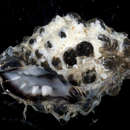ar
الأسماء في صفحات التنقل


Die Körnige Maulbeerschnecke oder Schwarze Maulbeerschnecke (Tenguella granulata, alternativ Morula granulata) ist eine Schnecke aus der Familie der Stachelschnecken, die im Indopazifik verbreitet ist und sich von Schnecken und Muscheln ernährt.
Das kegelförmige, längliche und kompakte Gehäuse der Körnigen Maulbeerschnecke, das bei ausgewachsenen Schnecken eine Länge von etwa 1,8 bis 3 cm erreicht, weist keinerlei Varicen auf. Es ist mit spiralig verlaufenden Reihen stumpfer Knoten und dazwischen verlaufenden Schnüren skulpturiert. Der Körperumgang weist 6 Reihen von Knötchen auf. Die äußere Lippe der Gehäusemündung ist mit 4 bis 5 Zähnchen besetzt. Die Grundfarbe des Gehäuses ist weiß, die Knoten darauf dunkelbraun bis schwarz, das Innere der Gehäusemündung schwärzlich, die Spindel und die innere Lippe weiß.
Die Körnige Maulbeerschnecke ist im Indopazifik von der ostafrikanischen und der südafrikanischen Küste KwaZulu-Natals, Mosambiks, Tansanias und Kenias über Aldabra, Chagos, Madagaskar und die Maskarenen ostwärts bis nach Australien (Northern Territory, Queensland, Western Australia) verbreitet, wo sie auf felsigen Untergründen in der Gezeitenzone zu finden ist.
Die Körnige Maulbeerschnecke frisst vor allem Muscheln und pflanzenfressende Schnecken, in deren Schale sie – ähnlich anderen Stachelschnecken – mithilfe ihrer Radula Löcher bohrt. Zu ihren Beutetieren gehören Schnecken der Gattungen Cerithium, Rissoina, Heliacus und Bittium sowie Muscheln der Gattung Hormomya.[1]
Die kompakte Gehäuseform mit dichten Umgängen und einer starken Skulpturierung sowie die enge Gehäusemündung mit ihrer gezähnten äußeren Lippe bieten Schutz gegen Fressfeinde wie Fische und Krebse, die Molluskenschalen knacken.[2] Trotzdem wird sie unter anderem von Raubschnecken wie dem mit Giftzähnen bewaffneten Nussatellakegel (Conus nussatella) erbeutet.[3]
Weibchen der Körnigen Maulbeerschnecke werden durch Imposex auf Grund der Gewässerbelastung mit Tributylzinn-Verbindungen geschädigt, einer Komponente von Schutzlack an Booten.[4]
Die Körnige Maulbeerschnecke oder Schwarze Maulbeerschnecke (Tenguella granulata, alternativ Morula granulata) ist eine Schnecke aus der Familie der Stachelschnecken, die im Indopazifik verbreitet ist und sich von Schnecken und Muscheln ernährt.
Tenguella granulata, common name the mulberry shell or the granulated drupe, is a species of sea snail, a marine gastropod mollusk in the family Muricidae, the murex snails or rock snails.[1]
The shell size varies between 18 mm and 30 mm. The conical, oblong shell is compact and contains no varices. It is covered with dark brown to black blunt knobs on a white background with spiral cords between the rows. The body whorl is covered with six rows of nodules. The outer lip is dentate with four to five teeth within. The narrow aperture is blackish. The columella and the inner lip are white.[1]
This globular shape, tight shell coiling, strong sculpture, a dentate outer lip and narrow aperture offers an added protection against shell-crushing predators, such as fishes and crabs.[2]
This mollusc is a predator and feeds by drilling sedentary or semi-mobile prey. It eats only other molluscs, mainly gastropods of the genera Cerithium, Rissoina, Heliacus, and Bittium, and the mussel Hormomya.[3]
Imposex in Morula granulata is a bioindicator for the presence of tributyltin (TBT) contamination (an anti-fouling paint for boats which affects females of the species).[4]
This species is can be found on a rocky substrate or reef flats in the intertidal zone. It is distributed in the Red Sea, in the Indian Ocean off Aldabra Atoll, Chagos, East Coast of South Africa, Transkei, Natal, Kenya, Madagascar, the Mascarene Basin, Mozambique and Tanzania, and in the Indo-West Pacific; also off Australia (Northern Territory, Queensland, Western Australia).
Fossils have been found in Quaternary strata of the Seychelles and Vanuatu, age range: 0.126 to 0.012 Ma
Tenguella granulata, common name the mulberry shell or the granulated drupe, is a species of sea snail, a marine gastropod mollusk in the family Muricidae, the murex snails or rock snails.
Tenguella granulata is een slakkensoort uit de familie van de Muricidae.[1] De wetenschappelijke naam van de soort is voor het eerst geldig gepubliceerd in 1832 door Duclos.
Bronnen, noten en/of referenties结螺(学名:Tenguella granulata),是新腹足目骨螺科Tenguella的一种。主要分布于台湾,常栖息在潮间带岩礁区。[1]